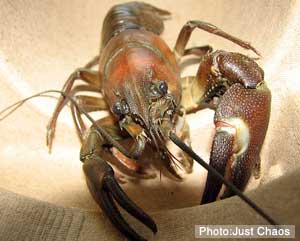 North American Signal Crayfish (NASC) have been discovered in Lochrutton, a loch in the lower western catchment of the River Nith. This invasive non-native species has been spread to a number of catchments in Scotland and is having an adverse impact on the native fauna. North American Signal Crayfish compete with native species for food and habitat and prey on native species seriously threatening biodiversity.
North American Signal Crayfish (NASC) have been discovered in Lochrutton, a loch in the lower western catchment of the River Nith. This invasive non-native species has been spread to a number of catchments in Scotland and is having an adverse impact on the native fauna. North American Signal Crayfish compete with native species for food and habitat and prey on native species seriously threatening biodiversity.
The presence of NASC in Lochrutton was discovered by the Nith Catchment Fishery Trust which has been monitoring waterbodies within the Nith catchment. The Trust identified NASC as a threat to the catchment as they are present in the adjoining catchments of the Clyde and in Loch Ken in Galloway. NASC have also been reported in the lower River Nith near Kingholm Quay but this sighting has not yet been verified. The Nith Catchment Fishery Trust is currently surveying the lower Nith for the presence of NASC.
Debbie Parke, Biologist with the Nith Catchment Fishery Trust said “The presence of North American Signal Crayfish in the Nith catchment is cause for great concern as these animals can have a devastating effect on the aquatic ecosystem. NASC burrow into river banks causing erosion, increasing the sediment load in the watercourses. They can also have a negative impact on fish populations, which is of concern to anglers in the Nith catchment.”
The Nith Catchment Fishery Trust is working with other agencies including the Scottish Environment Protection Agency, Scottish Natural Heritage and Scottish Government Marine Scotland, to formulate a plan to deal with the discovery of NASC in the Nith catchment. Eradication of NASC is impractical in large waterbodies so it is hoped that by educating water users and the public that the further spread of this species can be constrained.
Non-native species reach new areas through human involvement; often by persons ignorant of the damage that such actions can have, and once established can spread locally. For this reason, it is illegal to keep or release non-native crayfish and any caught accidently must be killed on site. A licence is required in order to trap for any crayfish. Signal crayfish can be accidently spread by using equipment, such as angling nets and boats, which have previously been used in a waterbody containing NASC. It is vital that all water users ensure they CHECK, CLEAN and DRY their equipment before using it elsewhere to prevent the further spread of these animals.
Jonathan Warren, operations officer with Scottish Natural Heritage in Dumfries said: “It is very disappointing that, despite the high level of publicity that has been given to this species and to non-native species in general, a new introduction has occurred in the region. It is impossible to eradicate Signal crayfish in such large waterbodies but, by working together, we hope we can contain the spread and minimise the impacts this new population could have.”
Carol McGinnes, from the Scottish Environment Protection Agency said: “This new finding in the Nith catchment reinforces the vital role that everyone has, particularly those who work in and around water or use it for leisure activities, in helping to protect our rivers and lochs from further spread of these creatures. This can be done by ensuring that animals and eggs are not transported accidentally between different waterbodies, by checking, cleaning and drying any equipment used, and by reporting any illegal trapping and/or movement of crayfish to the local Police.”
Signage will be erected and the issue of invasive non-native species will be continually kept as a high profile threat to the biosecurity of the Nith. All water users are encouraged to follow the simple guidance set out in the Check, Clean, Dry campaign, which can be found at www.nonnativespecies.org, to prevent the spread of non-native species.
If you suspect that Signal crayfish are present in any watercourse within the Nith catchment, please inform the Nith Catchment Fishery Trust: email trust@river-nith.com or telephone 01387 740043.
Note to Editors
For further information please see the following links:
SNH Crayfish leaflet
http://www.snh.gov.uk/docs/C209048.pdf
NASC Risk Assessment https://secure.fera.defra.gov.uk/nonnativespecies/downloadDocument.cfm?id=54
GB NNSS website
https://secure.fera.defra.gov.uk/nonnativespecies/home/index.cfm
